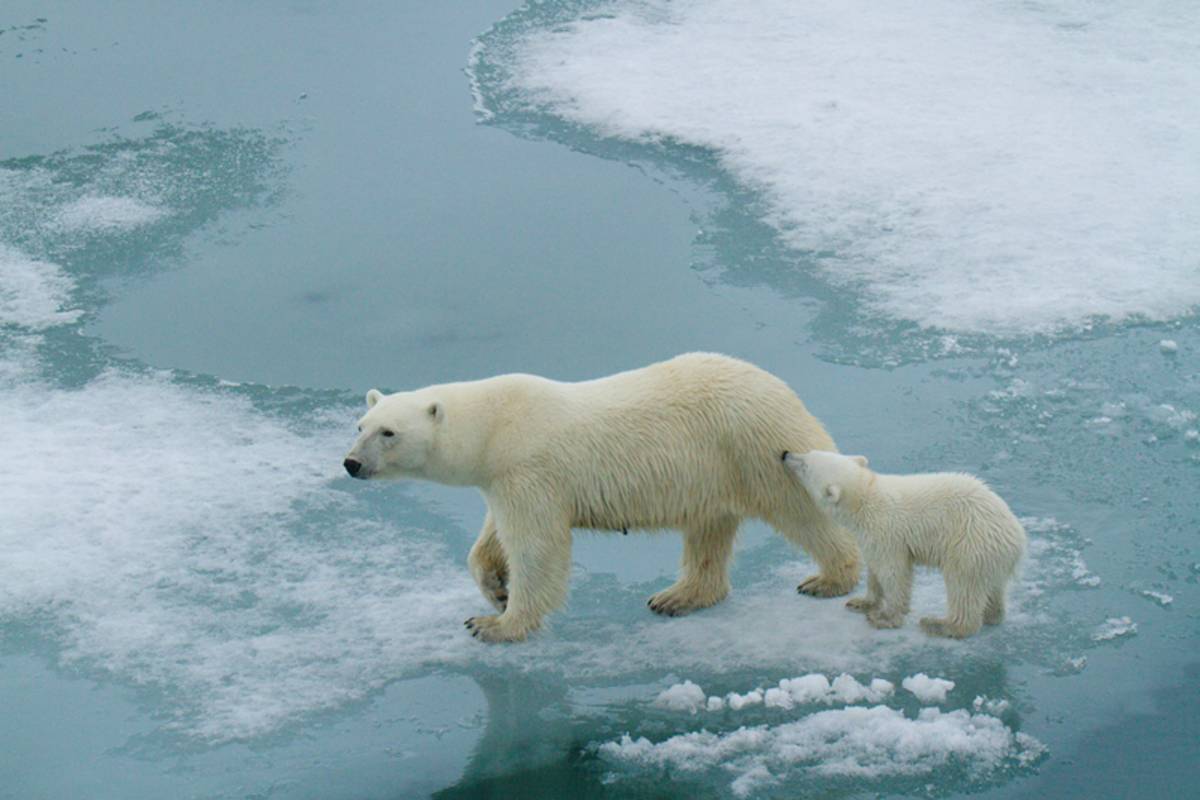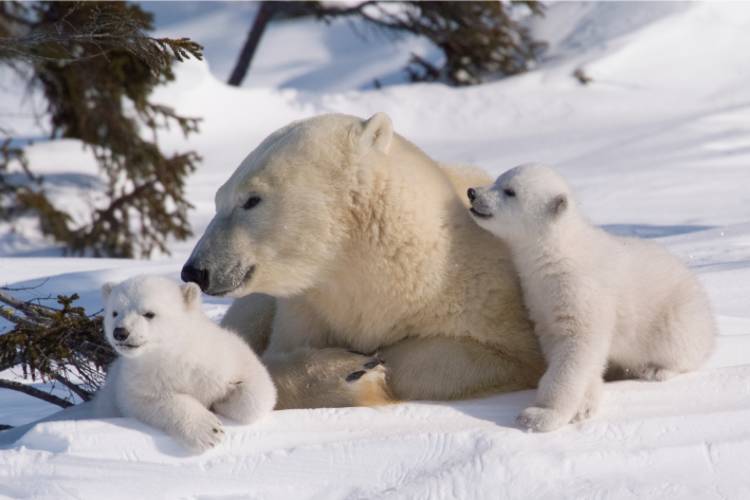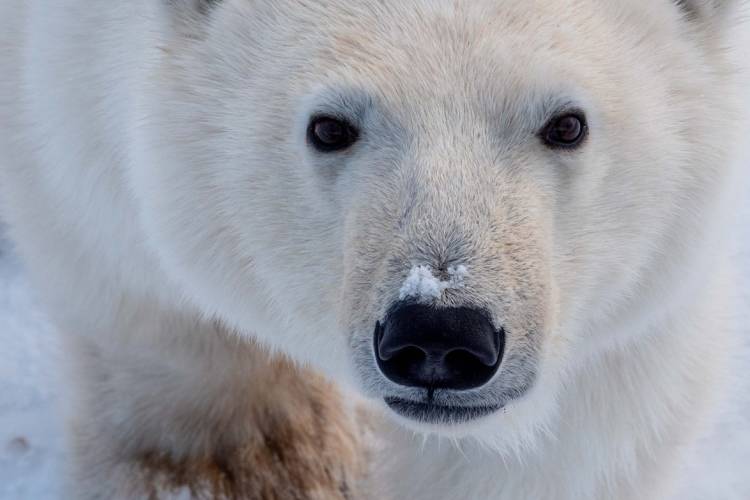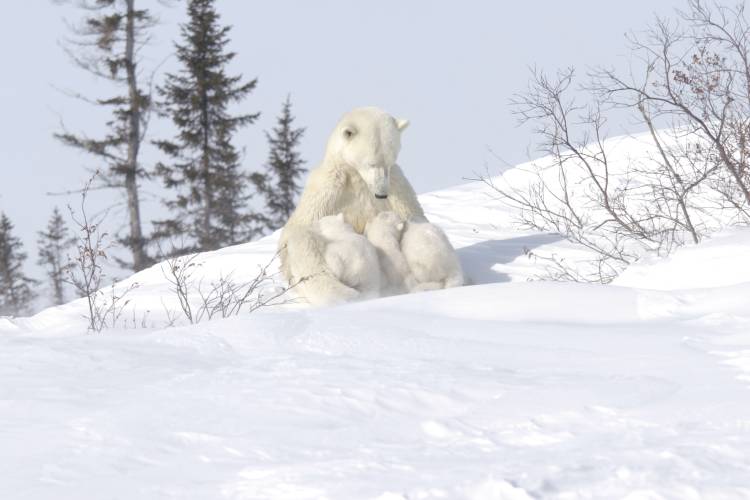
Photo: Kt Miller / Polar Bears International
New Paper Provides Climate Policy Framework
MINS
31 Aug 2023
Bozeman, Montana – August 31, 2023 – In a new paper, scientists with Polar Bears International, the University of Washington, and the University of Wyoming have, for the first time, quantified a direct link between greenhouse gas (GHG) emissions and polar bear survival. Published today in Science, the report, “Unlock the Endangered Species Act to address GHG emissions,” provides a template for estimating the demographic impact of proposed GHG-emitting actions on polar bears—overcoming a loophole in the Endangered Species Act (ESA) that has historically blocked climate considerations. The approach outlined in the paper connects the dots between greenhouse gas emissions, the number of ice-free days caused by specific amounts of emissions, and polar bear survival rates. It also explains the recent declining trends observed in some polar bear subpopulations.
Background: Although polar bears were listed under the Endangered Species Act (ESA) in 2008 because of sea ice loss caused by climate warming, then-Solicitor of the Department of the Interior, David Bernhardt, issued a legal opinion stating that ESA considerations of emissions would not be required unless the impact of emissions from considered projects could be separated from the impact of all historic global emissions. The inability to make that separation and measure the impact of a specific project meant that climate change—the very reason polar bears were listed—was blocked from inclusion in ESA evaluations.
“We’ve known for decades that continued warming and sea ice loss ultimately can only result in reduced distribution and abundance of polar bears,” says lead author Dr. Steven Amstrup, chief scientist emeritus at Polar Bears International and an adjunct professor at the University of Wyoming, adding, “But until now, we’ve lacked the ability to distinguish impacts of greenhouse gases emitted by particular activities from the impacts of historic cumulative emissions. In this paper, we reveal a direct link between anthropogenic GHG emissions and cub survival rates. The methodology, for the first time, allows us to parse the impact of emissions by source. Importantly, the approach we describe, using regression analysis to connect GHG emissions to habitat and demographic changes, also has broad application beyond polar bears to other ecosystems and species—and could be used by managers and policymakers around the world when evaluating development projects.”
More Context on the Findings and Methodology: Building on the foundation established in a 2020 report linking projected polar bear survival against summer fasting duration caused by global warming, this paper takes the additional step of quantifying the number of ice-free/fasting days caused by a specific amount of CO2-eq emissions, thus allowing for a direct calculation of the impact of a project’s emissions on future polar bear cub recruitment. For example, the hundreds of power plants in the U.S. together will emit 60+ Gt emissions over 30+ year lifespans, which reduce cub recruitment in the Southern Beaufort Sea population by ~4%.
The Bernhardt Memo Explained: In 2008, based on projections that up to two-thirds of the world’s polar bears could disappear by mid-century, polar bears became the first species listed under the ESA due to threats from human-caused climate warming. Section 7 of the ESA provides a process ensuring that government-authorized projects (including oil and gas leases) do not further endanger any ESA-listed species. Shortly after polar bears were listed, however, then-Solicitor of the Department of Interior David Bernhardt issued Memo M-37017, claiming impacts of emissions from any individual action or group of actions being considered could not be separated from the impact of historic emissions that have been accumulating since the beginning of the Industrial Revolution. The limitation described in the Bernhardt Memo has prevented inclusion of global warming emissions from oil and gas leasing, and other GHG-emitting activities, in ESA Section 7 reviews—even though global warming, resulting from GHG emissions, was the reason polar bears were listed in the first place. This new report, published during the 50th-year anniversary of the ESA and 15th-year anniversary of polar bears being listed under the ESA, directly fills the knowledge gap identified in M-37017, allowing GHG emissions from any action to be parsed from historic emissions. This will allow rescission of the Bernhardt Memo and inclusion of GHG pollution in the review of future actions.
"Overcoming the challenge of the Bernhardt Memo is absolutely in the realm of climate research,” says co-author Dr. Cecilia Bitz, professor of atmospheric sciences at the University of Washington, noting, “When the memo was written in 2008, we could not say how greenhouse gas emissions equated to a decline in polar bear populations. But within a few years we could directly relate the quantity of emissions to climate warming and later to Arctic sea ice loss as well. Our study shows that not only sea ice, but polar bear survival, can be directly related to greenhouse gas emissions."
Implications:
Other Species: The implications of this study go far beyond polar bears and sea ice. The methodology of using regression analysis to link emissions to environmental consequences may be easily adapted for other species and habitats, such as coral reefs, Key Deer, or beach-nesting species impacted by rising sea levels.
U.S. Policy: This report finally addresses the obstacle posed by the Bernhardt Memo and creates a direct link between emissions from individual projects and impacts on ESA-listed species. This gives the Department of Interior the scientific basis needed to rescind the Bernhardt Memo and start including GHG emissions in reviews of all new projects it considers.
International Policy: While this report directly addresses a gap in U.S. policy, it has wider implications especially as oil and gas leasing activities continue around the world. Further, this report enables assigning accountability, as emissions can be traced to specific projects and companies looking both backward and forward in time. Such long-term transparency and traceability can inform more sustainable businesses and policies as countries aim to achieve climate and biodiversity targets.
"When polar bears were listed as threatened in 2008, we talked about global warming and the risk of losing this iconic ambassador of the Arctic. Today, over 15 years later, my colleagues Amstrup and Bitz show unequivocally that those perceived risks are real,” says Dr. Merav Ben-David, Wildlife Ecology Professor at the University of Wyoming, who has been studying polar bears with Dr. Amstrup for over 20 years but was not involved in the current project, adding, “They show that reproductive failure is tied to greenhouse gas emissions. At a time when people die from the effects of extreme climate events, we may have forgotten the plight of polar bears. But we shouldn’t."
About Polar Bears International
Polar Bears International’s mission is to conserve polar bears and the sea ice they depend on. The organization works to inspire people to care about the Arctic, the threats to its future, and the connection between this remote region and our global climate. Polar Bears International is the only nonprofit organization dedicated solely to wild polar bears and Arctic sea ice, and the staff includes scientists who study wild polar bears. The organization is a recognized leader in polar bear conservation. For more information, visit www.polarbearsinternational.org.
About the University of Washington
The University of Washington was founded in 1861 and is one of the preeminent public higher education and research institutions in the world. The UW has more than 150 members of the U.S. National Academies, elite programs in many fields, and annual standing since 1974 among the nation's top five universities in receipt of federal research funding. Learn more at uw.edu.
Media Contacts
Annie Edwards, Polar Bears International — annie@fabricmedia.net, +44 0 7307 139 782
Melissa Hourigan, Polar Bears International — melissa@fabricmedia.net, +1 720 988 3856
Hannah Hickey, UW News — hickeyh@uw.edu +1 206 543 2580















